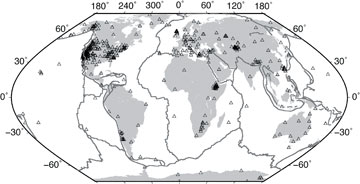|
NEWS NOTES
Big quake … little quake
 Aaron Velasco, University of Texas, El Paso |
| Triangles mark the locations of hundreds of small, dynamically triggered earthquakes all over the world. |
Meteorologists know that weather patterns on one side of the globe can affect forecasts half a world away. Now seismologists have discovered large earthquakes may have similar far-flung effects. A new study published in May in Nature Geoscience shows large earthquakes often trigger smaller tremors worldwide, in some cases on the opposite side of the planet.
Earthquakes commonly produce smaller quakes and aftershocks close to the fault rupture. These tremors result from changes in underground stresses around a newly ruptured fault, a mechanism known as static triggering, says co-author Kris Pankow of the University of Utah in Salt Lake City. The new idea, however, is based on “dynamic triggering,” which occurs when seismic waves produced from a large earthquake set off tremors in a distant location.
The idea that big earthquakes could trigger distant quakes came about in 1992 after the magnitude-7.3 Landers earthquake in California sparked tremors hundreds of kilometers away under Yellowstone National Park. Before the Landers quake, “earthquakes would pop up at the same time and seismologists would insist the quakes were random, that there were no connections,” says Susan Hough, a seismologist with the U.S. Geological Survey in Pasadena, Calif., who has also studied dynamic triggering. “But Landers was clearly connected to Yellowstone so we accepted remote triggering, but thought it only occurred in tectonic hotspots,” where lots of tectonic activity was already occurring.
Then in 2004, after the catastrophic magnitude-9.2 Sumatran quake closely coincided with jolts in Alaska and Ecuador, a team of researchers led by Aaron Velasco of the University of Texas, El Paso began systematically studying major seismic events between 1992 and 2006, looking for more evidence of long-distance quake triggering all over the globe, in many different tectonic environments, both active and quiet.
Meanwhile, Pankow began by investigating the 2002 magnitude-7.9 Denali earthquake. Looking at seismic data from Yellowstone National Park, she found that dozens of magnitude-4 and smaller quakes had indeed rocked Yellowstone starting minutes after the Denali quake. The Denali-Yellowstone study not only confirmed dynamic triggering, it yielded another piece of information: Yellowstone’s tremors coincided perfectly with the passing of surface waves from the Denali quake, Pankow says.
Then, using data from Incorporated Research Institutions for Seismology, Velasco, Pankow and their colleagues analyzed data from more than 500 seismometers five hours before and five hours after 15 major earthquakes, all larger than magnitude 7. They found that in 12 out of 15 cases, surface waves from major earthquakes sparked smaller seismic events hundreds and even thousands of kilometers away. And furthermore, “dynamic triggering seems to occur in a variety of tectonic settings, even in those not normally prone to earthquakes like the Canadian Shield and Australia,” where minor seismic events were triggered by earthquakes in Alaska and Sumatra, Pankow says. This variety of tectonic settings suggests a complicated underlying mechanism for dynamic triggering, she says. Even the triggers themselves are not well understood, she says: Dynamic triggering of far-off quakes seems to occur with the passing of either Love or Rayleigh waves or both. Although Love and Rayleigh waves are both surface waves, they move very differently from one another, further masking the exact trigger mechanism, Pankow says. “Right now we just don’t know what sets off these smaller quakes.” Nonetheless, dynamic triggering seems to be the rule rather than the exception following major quakes, the authors suggest: It is “a ubiquitous phenomenon,” they wrote.
As to what triggers these quakes, Pankow has a few ideas: It’s possible, she says, that the passing surface waves may change the flow of water in a fault, or such waves could affect the stress-strain forces in a locked fault, causing slippage. “Directivity may also play a role,” she says. If a major fault rupture is oriented in the same direction as a distant fault line, like in the Denali-Yellowstone example, the fault alignment may facilitate triggering of smaller far-off quakes. The next step, she says, “is to set up modeling studies to look closely at some of the more surprising triggered quakes to figure out how and why they occurred.”
And while there may be some buzz about using dynamic triggering to predict secondary earthquakes, Hough says the hazard implications of this study are few. “If there’s a big quake somewhere, we can’t predict a greater likelihood of it triggering another one in a specific place; the probabilities are just too low.” However, she says, the study might help seismologists better understand how earthquakes behave. “We usually know how earthquakes happen — strain builds in rock until the fault breaks — but we still can’t predict where they will occur or when,” she says. “Dynamic triggering is something of a new paradigm shift in seismology. Maybe it will give us the data we need to better understand why and when earthquakes happen.”
All kinds of wavesDuring an earthquake, energy is released in the form of four types of seismic shock waves that travel through Earth’s crust and mantle. P-waves, the swiftest seismic waves and usually the first to arrive at a seismic station, move through Earth by alternately compressing and dilating the ground in their path in a slinky-like push-pull motion. Shear waves, or S-waves, are the next to arrive, propagating forward in wave pulses that push the ground in a side-to-side motion like the waves in a rope. The slowest waves are Love and Rayleigh waves, both of which travel through the ground close to Earth’s surface and can therefore cause most of the ground shaking and damage during a quake. Love waves shear the ground from side to side, while Rayleigh waves roll across the land surface like waves in the ocean. |

 Subscribe
Subscribe


